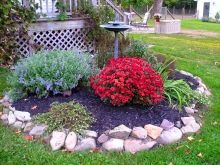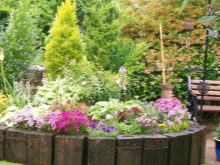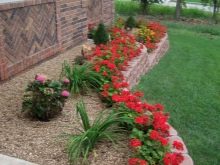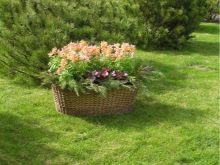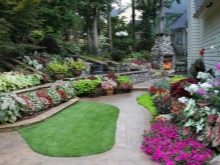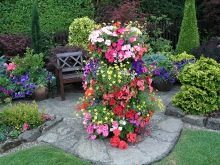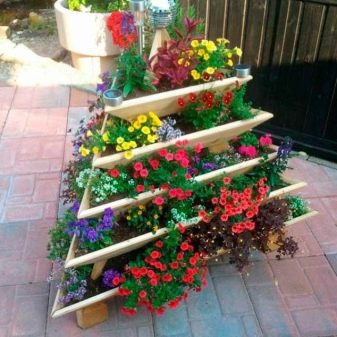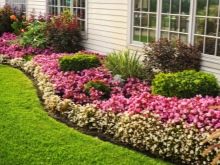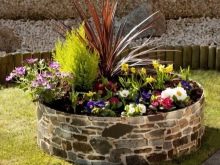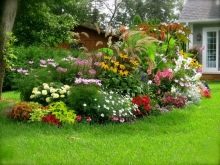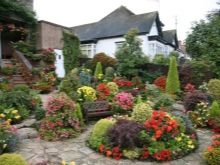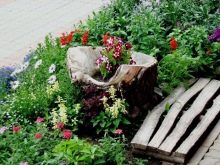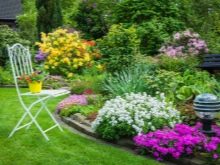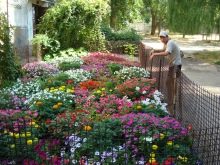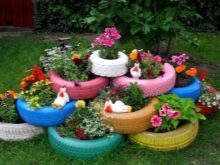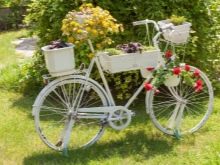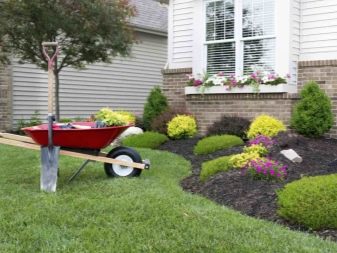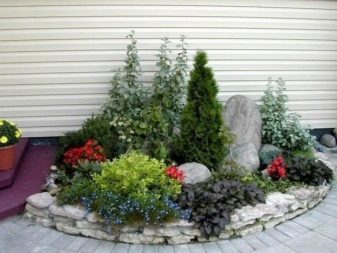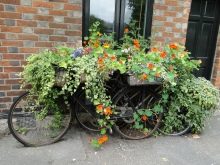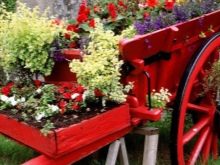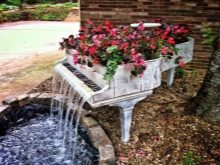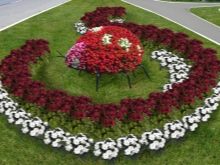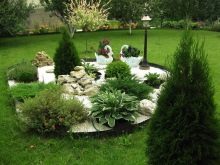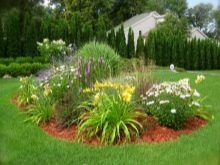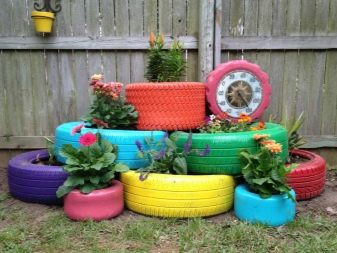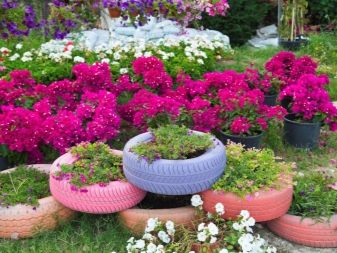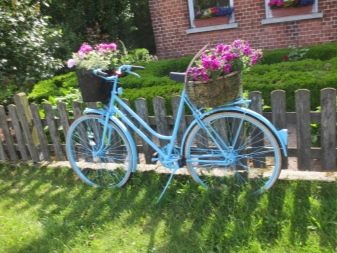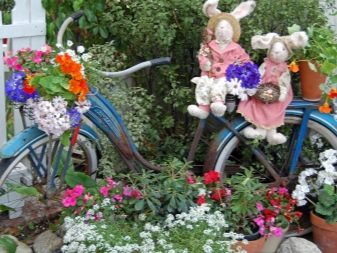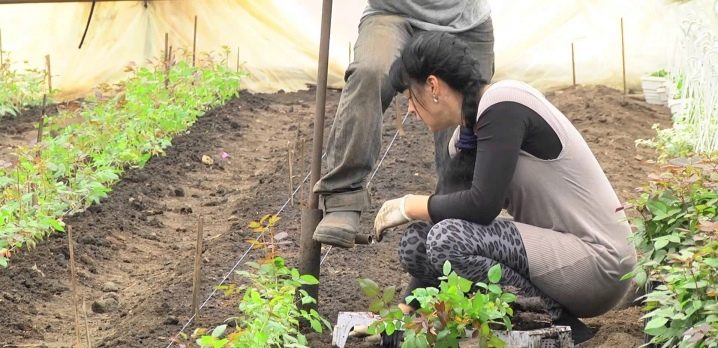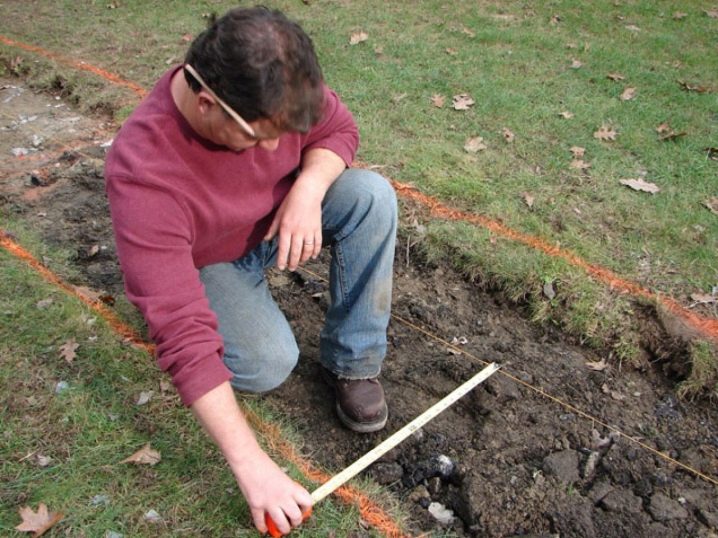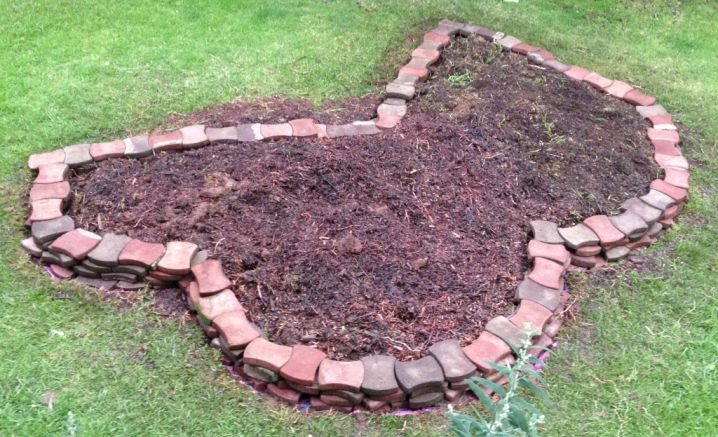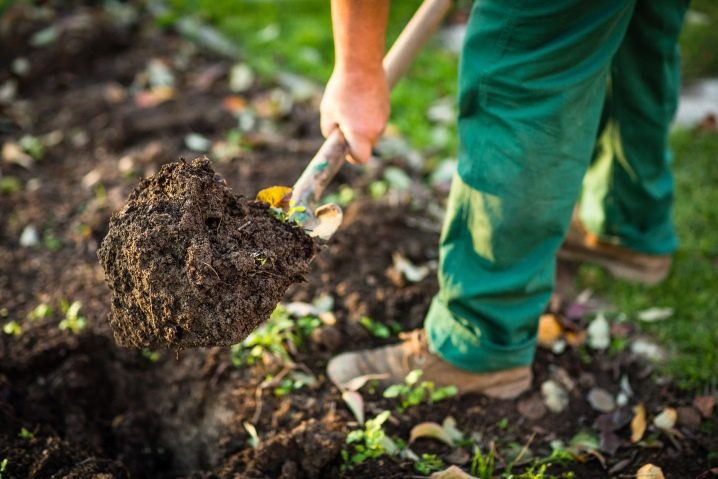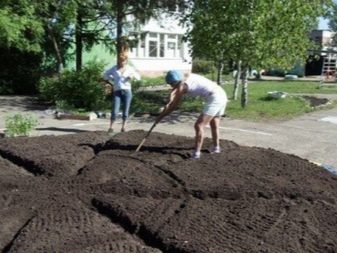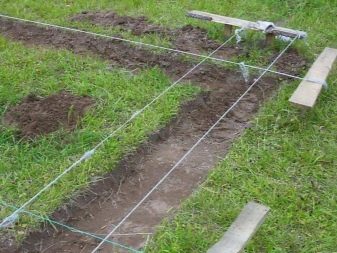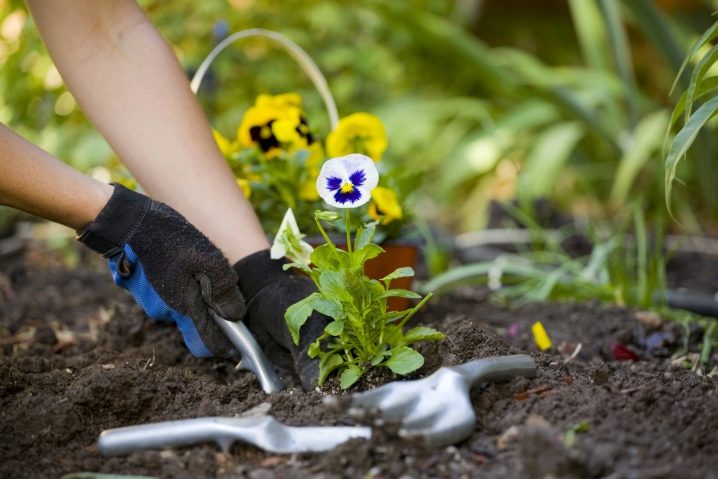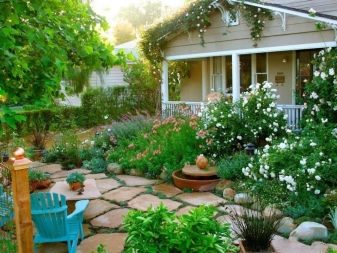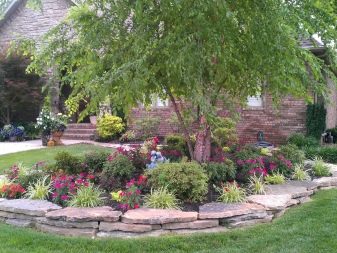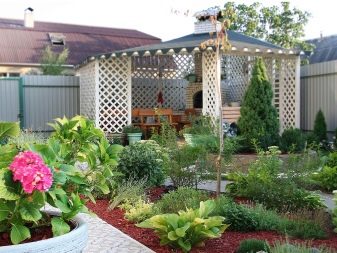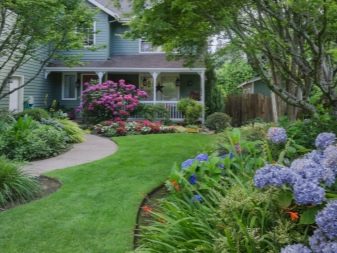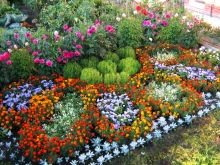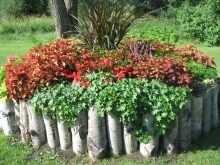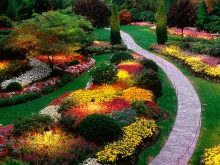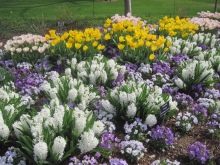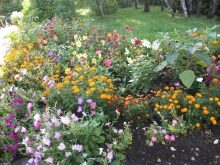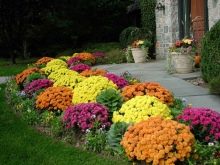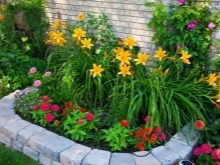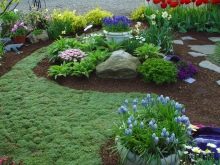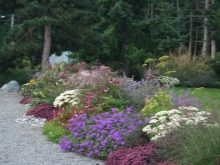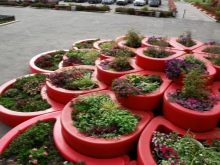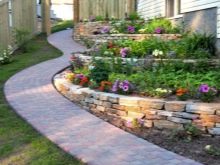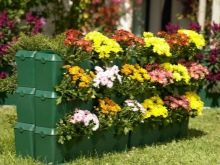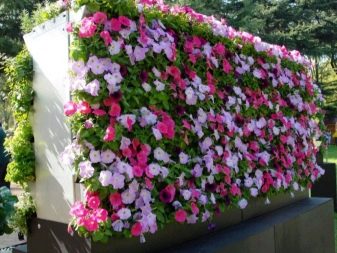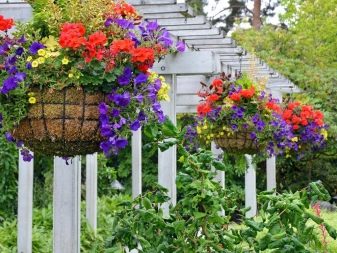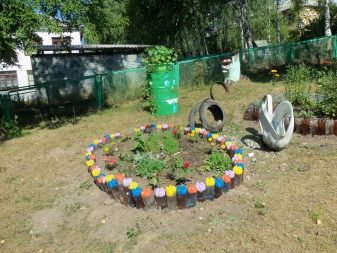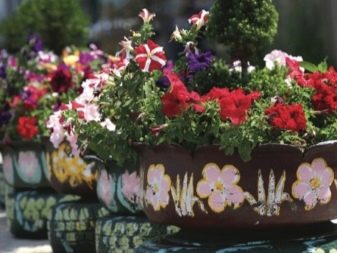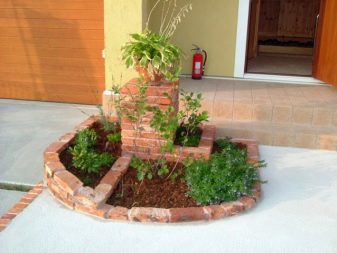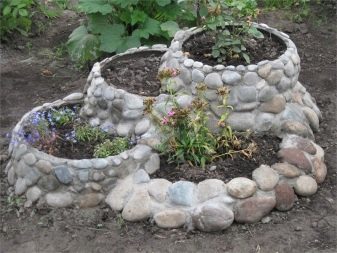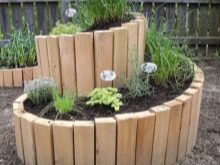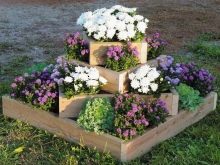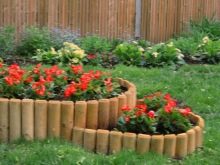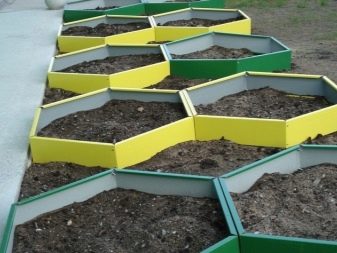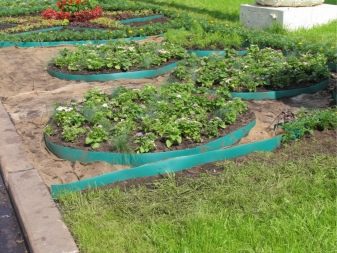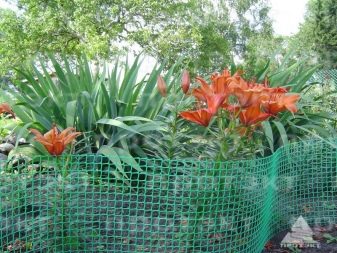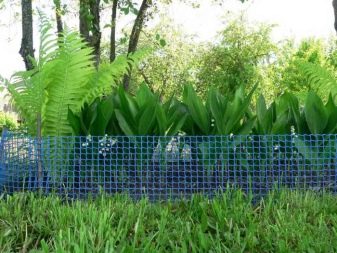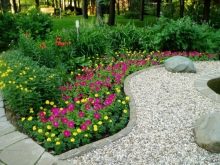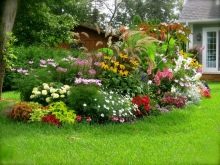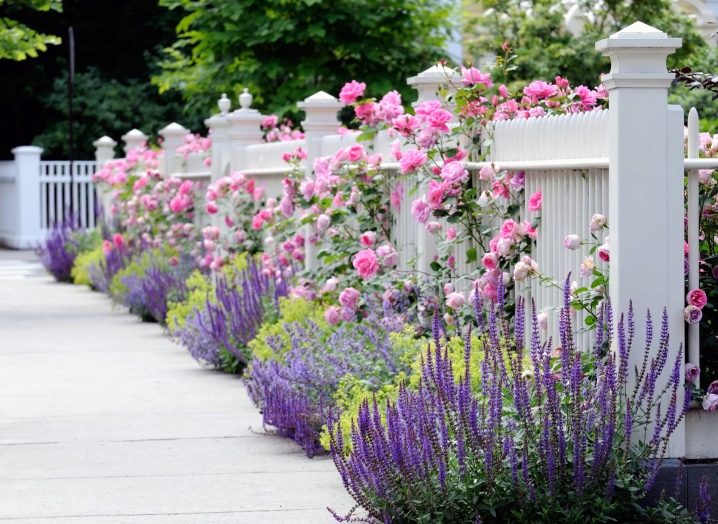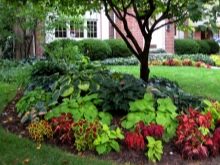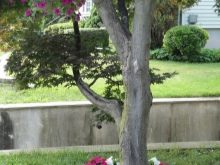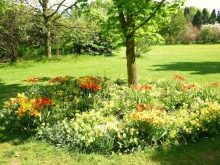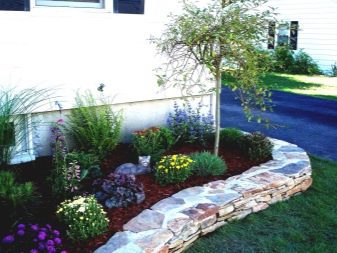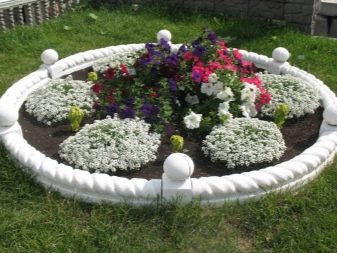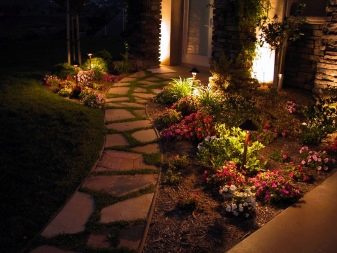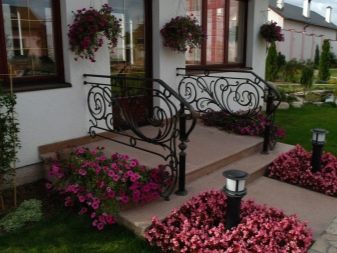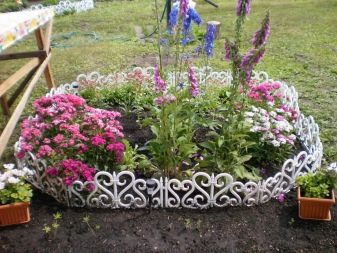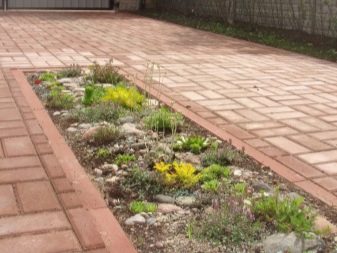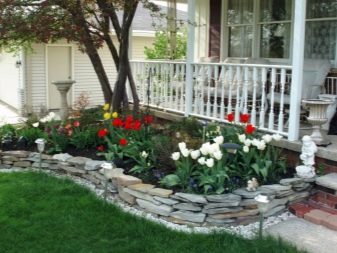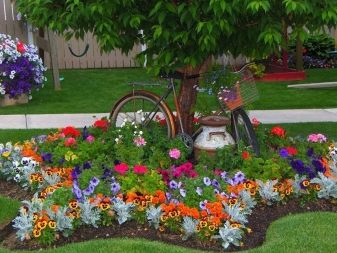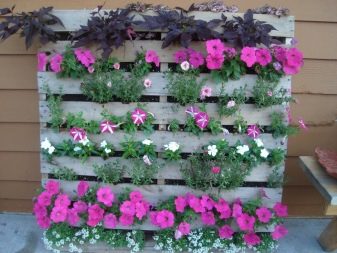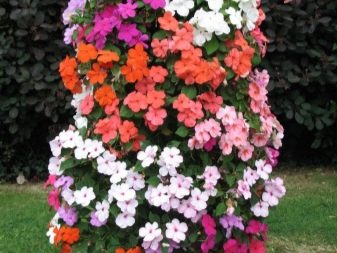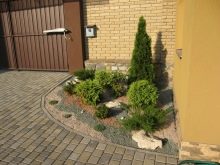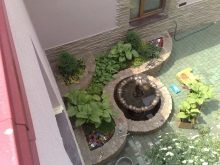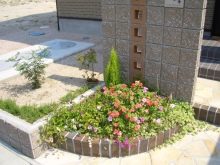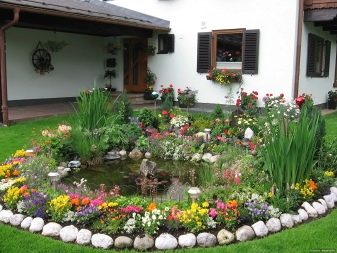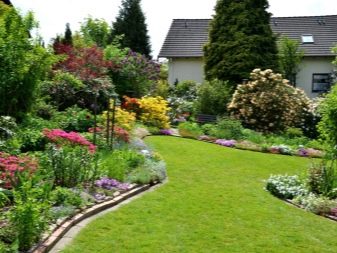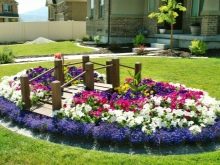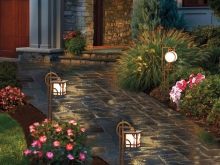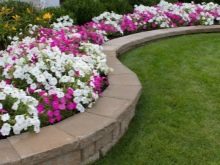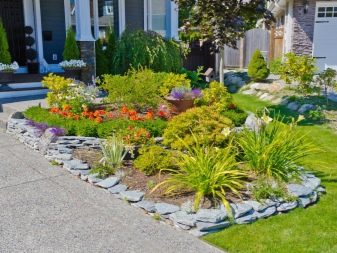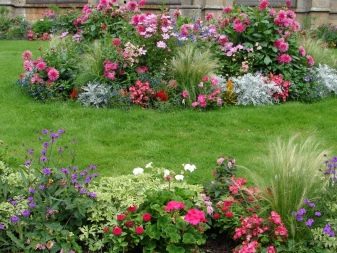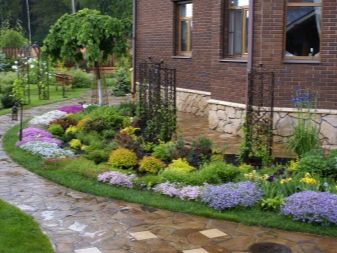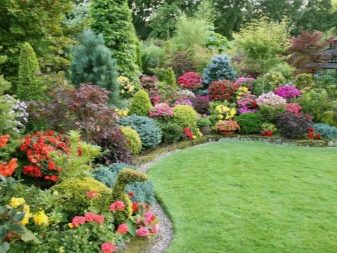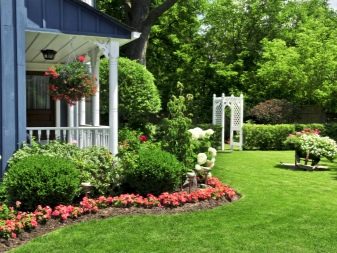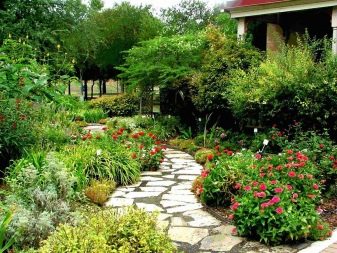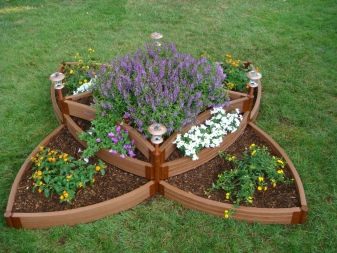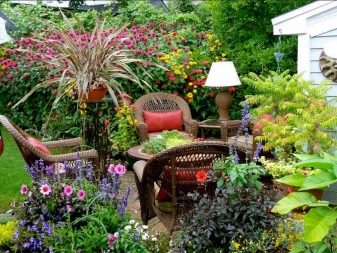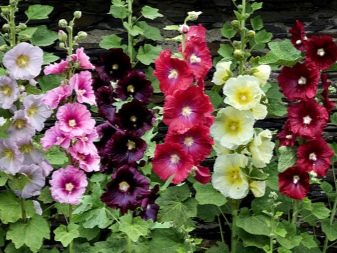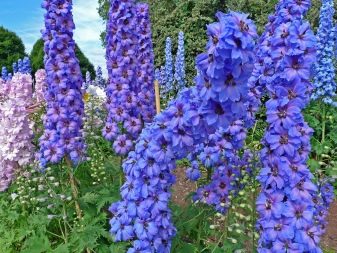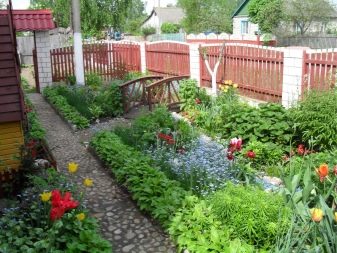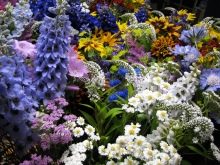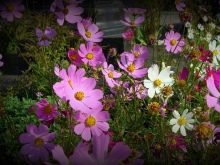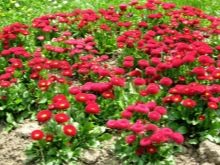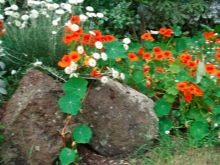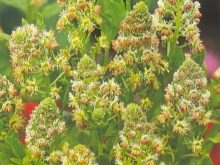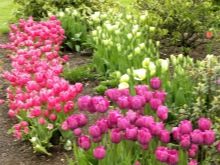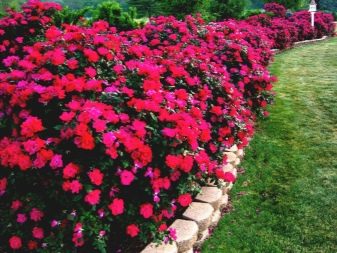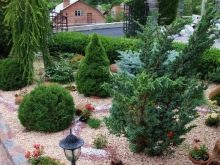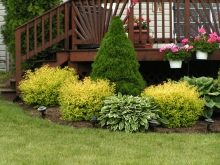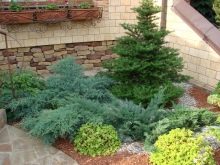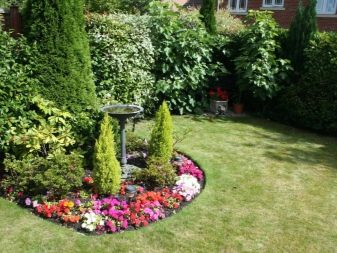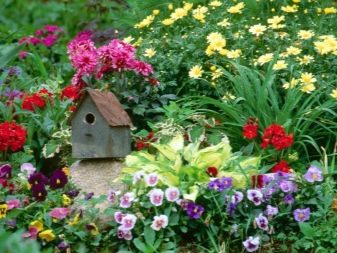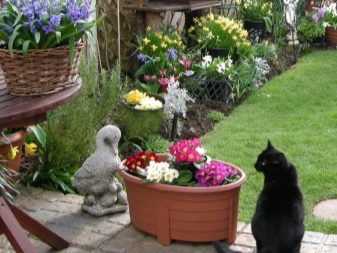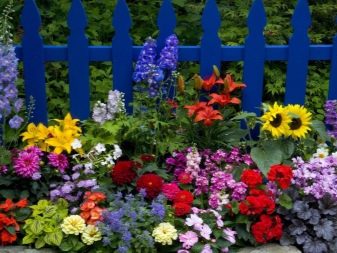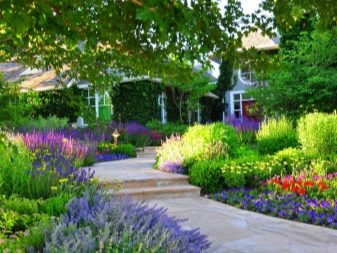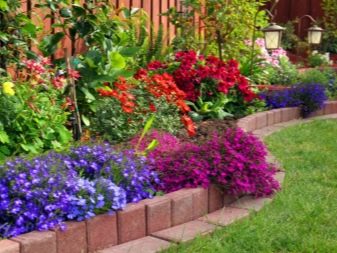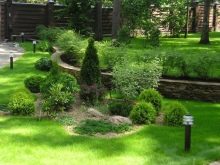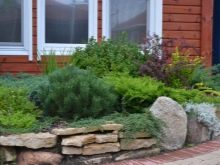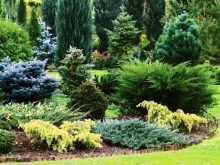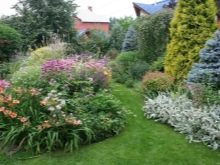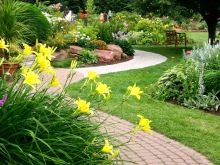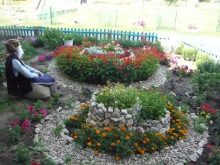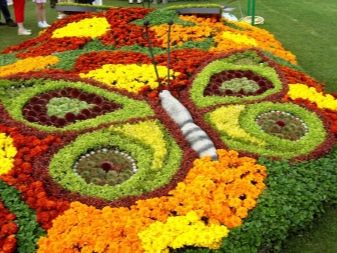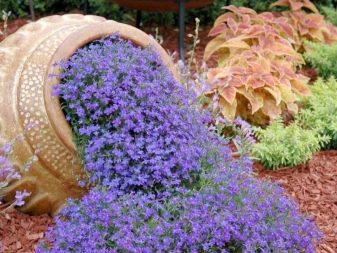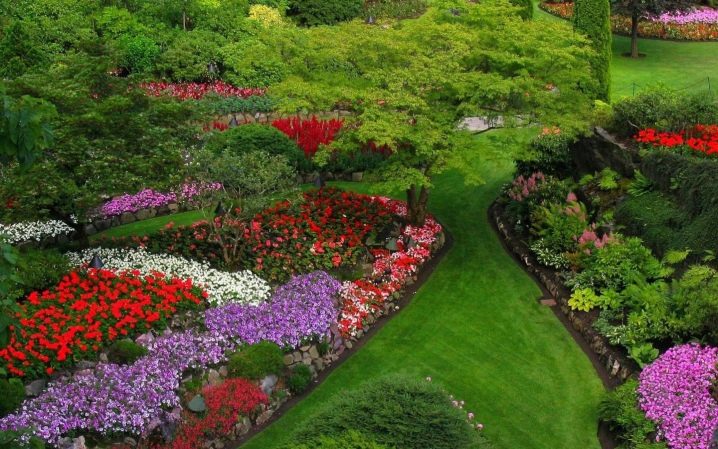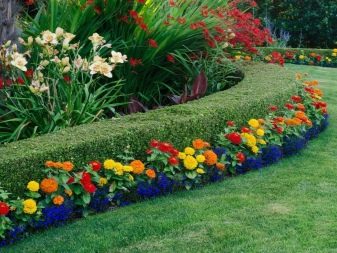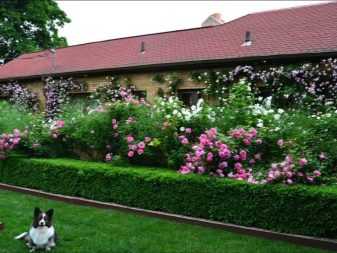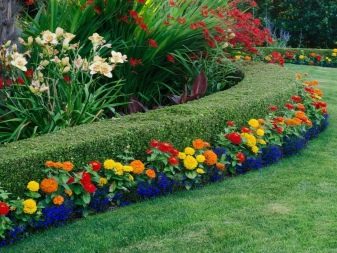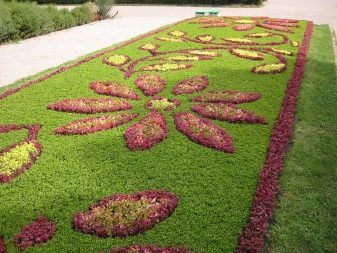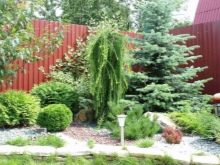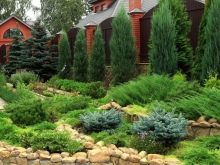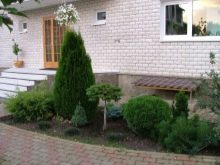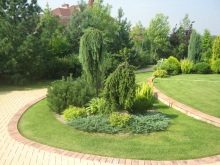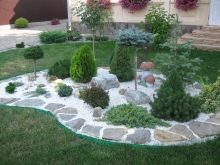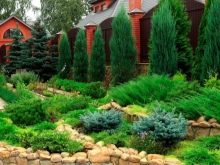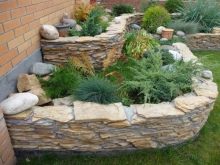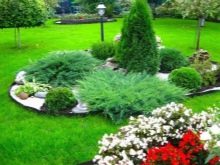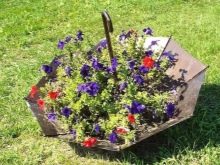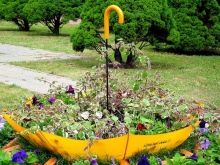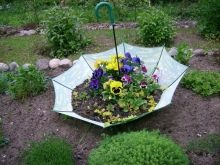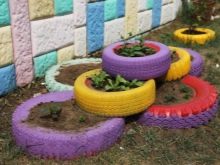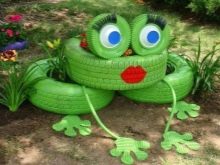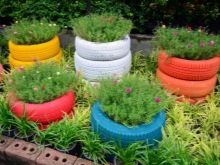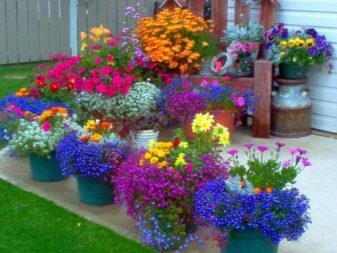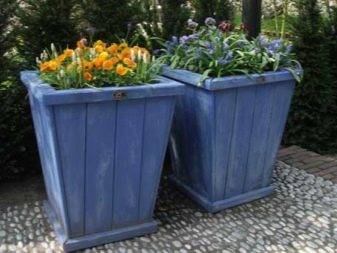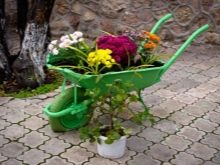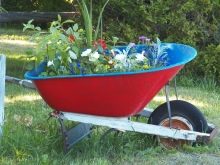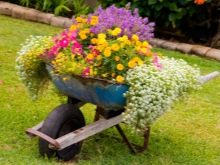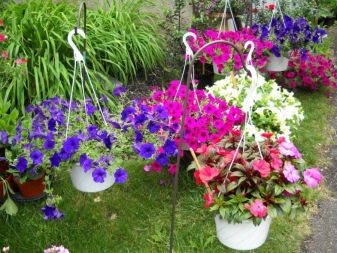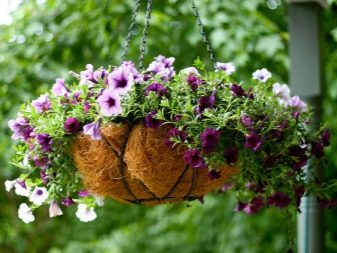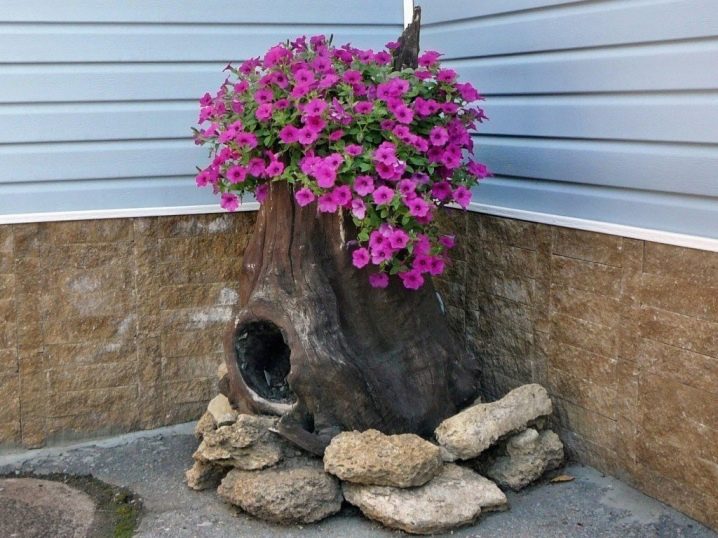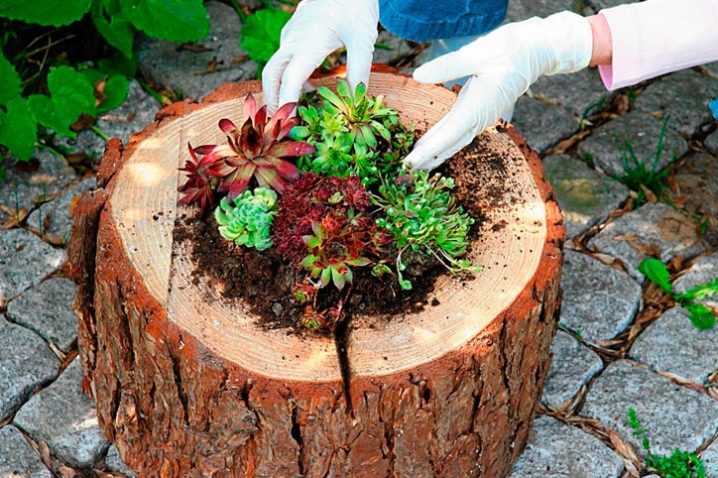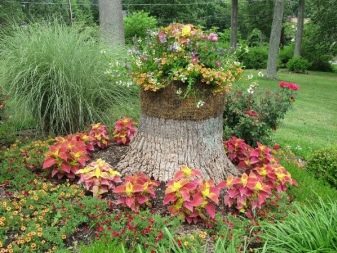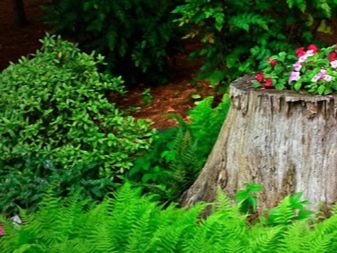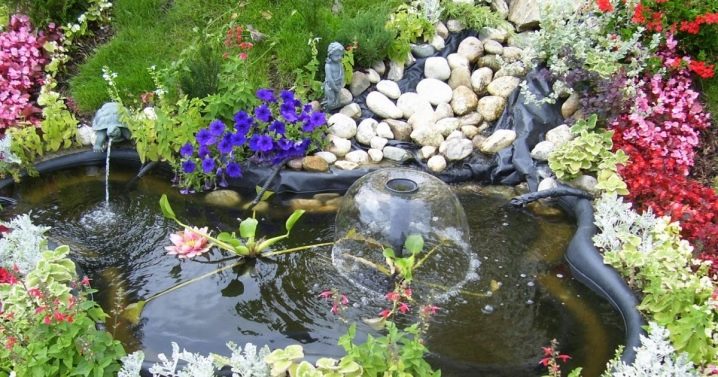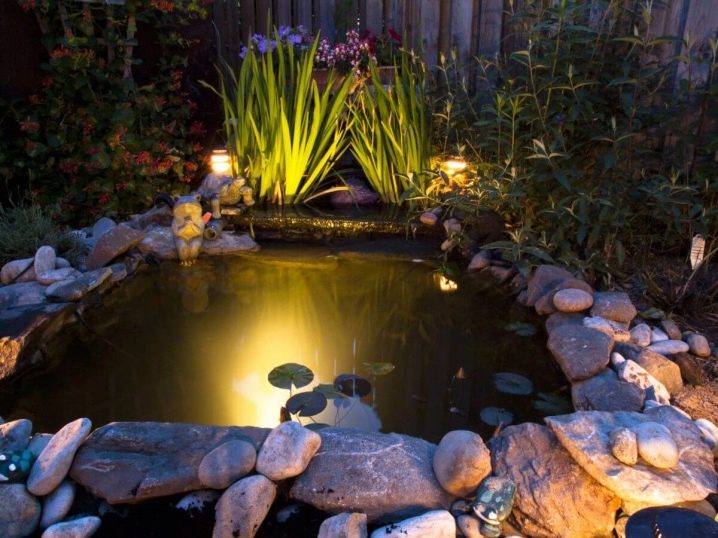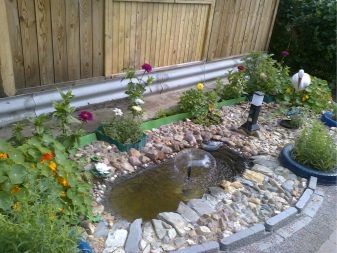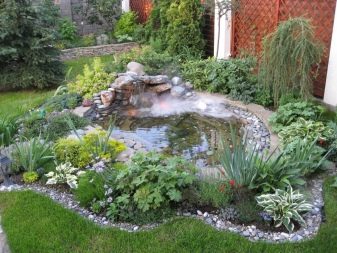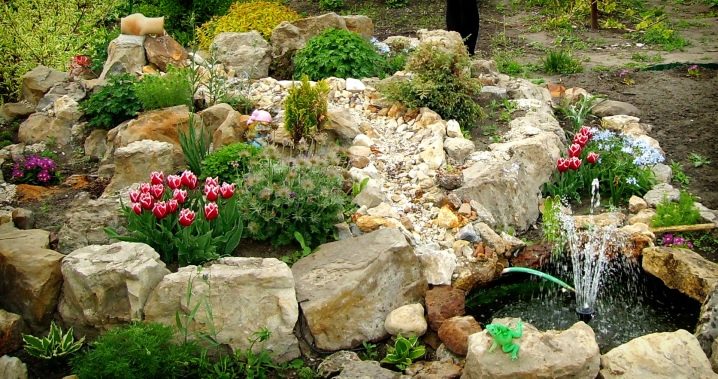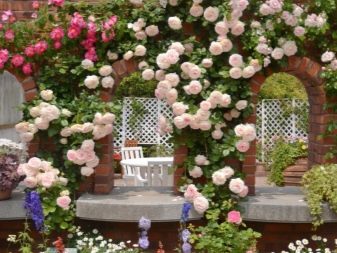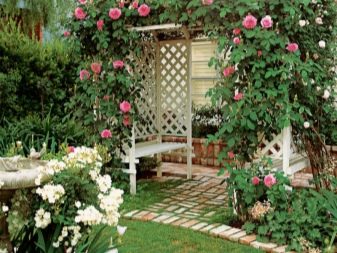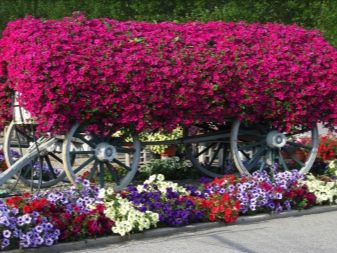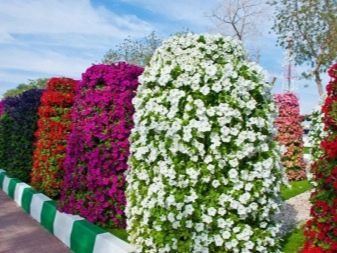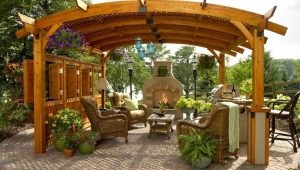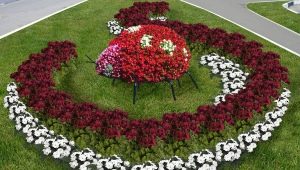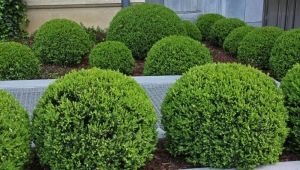Beds for summer cottages and country houses: types and their design
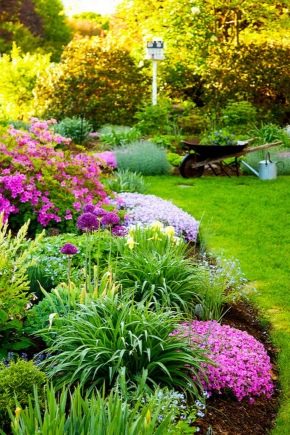
In spring or summer, when the sun is shining in the courtyard, I want to escape from the stuffy city to nature. For many, the summer cottage seems to be hard labor, in which it is necessary to continuously dig up, pile up, weed and weed and work hard. But a country house can also serve as a place of rest for the whole family, and therefore I want the site in front of the house to look beautiful.
For registration of cottages and country houses are perfect for various types of flower beds.
What it is?
Usually a flower bed is a plot of land on which the flower garden is broken. As a rule, this area is somewhat elevated above the general level of the soil and represents a regular geometric figure - square, rectangle, circle, oval, ellipse, etc.
A distinctive feature of a flower bed is its conditional isolation from other garden space. Such a flower garden is usually fenced with a stone or brick curb, which is supposed to protect plants from trampling down and keep the flower garden in its originally defined geometric shape.
Quite popular design solutions are cascade beds, consisting of several kind of "floors", forming a single composition.
Plants for flower beds are selected depending on the intended color scheme; often plants are planted in such a way that during flowering to form a certain pattern or pattern. To emphasize these floral images, colored crushed stone or pebbles can be used.
Special features
It is worth looking at at least a few variants of flowerbeds, in order to understand that landscape designers are rarely limited to standard single-tier flowerbeds with a low border. Yes, undoubtedly, due to the fact that such flower beds are broken most easily and simply, most gardeners (especially if they do all the work themselves) prefer this kind of flower beds.
But if the gardener already has experience in the device of the most simple flower gardens and wants to diversify the landscape of the summer cottage which has become boring for a long time, then there comes a time for all sorts of experiments. In place of a single-tier flower bed, a multi-level flower bed can come in, decorated, for example, with a fountain or an artificial pond.
The most unusual are street flower gardens. The space in front of the house is usually smaller than the territory of the courtyard, so the flowerbeds located on the front side of the house, as a rule, are moderately compact and curious in appearance.
Along the edges of the porch, you can install vertical flower beds; some owners use old car tires for flower beds, others install sculptural compositions from old bicycles and even cars.
It is also a delusion that the flowerbed must always be located on the ground. If part of the courtyard on the site is filled with concrete, then nothing prevents to put a flower bed, for example, near the walls of a house or a garage.
Style and design
With a certain amount of imagination, a flower bed can become a true masterpiece of design art.At the same time, the design does not necessarily require large expenses from the owner: for many original solutions, old things like old bicycle, car tires, leaky carts, or, at first glance, perfect garbage like plastic bottles will come in handy.
The standard option is considered a flower bed, arranged in the middle of the site. However, there are a great many types of this “standard” variant. Start with the fact that The flower garden in the center of the garden can be of various forms: round, square, triangular etc. In addition, such a flower bed can be multi-tiered, and since it will inevitably focus on attention because of its location, a fountain can be arranged in its center.
Flowers in the flowerbed can be planted in the form of a pre-designed pattern. These can be chess cells, circles, spirals, or a smooth gradient. No less interesting looks striped flowerbed. It is only necessary to decide what exactly the gardener wants to see on his plot in order to think over in advance with the drawing which colors and flowers are best to combine.
Gloomy and repulsive car tires can be amazing in their simplicity and attractiveness flowerbed.Before embarking on a design, the tire should be thoroughly cleaned and cleaned to prevent gasoline, engine oil or other harmful substances from entering the soil. And then the dried tires give the necessary shape, paint, fill with soil and plant them.
Original flower beds can come from an old bicycle, holey rubber boots. In the dismantled bath, you can sit on the daisies or bright marigolds and asters.
How to do it yourself?
Before you begin the process of creating a flower bed, you need to think through a lot of small, but very important details. First of all, you should attend to the place where the future flower garden will be broken. Ideally, this should be a well-lit space.so that sun-loving plants do not lack sunlight. Otherwise, it is worthwhile to devote a little more time to the selection of plants for flower beds and to find shade-loving varieties that can grow and bloom properly, even in case of a lack of lighting.
The next step will be the immediate planning of the flower bed itself. It is necessary to make a preliminary sketch of the future flower garden on paper,to make a choice of plants depending on their color, shape and size, as well as periods and duration of flowering. It is necessary to figure out in advance what can be purchased from seedlings ready-made, and what will have to be sown independently in a greenhouse.
Creating a floral pattern, you should not chase after complex drawings, because its execution will be just as difficult. Difficulties may arise both at the stage of selection of suitable plants, and in the process of planting them on the prepared soil.
When the preliminary preparations are completed, the plan of the future flowerbed is drawn and the plants necessary for its realization are selected, you can proceed to marking the perimeter for the future flower garden.
The place where the flowerbed will be broken must be carefully dug and leveled, to get rid of possible bumps or dimples, dips in the ground. If, according to the design plan, the flower bed needs to be insulated with a border that will not interfere in the process of planting plants (that is, it will not be very high), then it is better to install it already at this stage.
The next step, directly connected with the previous one, is the creation of a relief of a flower bed. A flower bed can be a flat piece of soil, it can slightly rise above the rest of the surface, or be inclined.
The easiest way to level the surface for a flat flower bed. If the top layer of soil at the site of planting is fruitful, then all weeds are removed from it, after which the earth is carefully dug up. Barren soil will need to be removed, and instead add humus with peat and fertilizer required for cultivated plants.
In order to make a flowerbed towering above the general landscape, it will be necessary to make a ground bed. Most often, this is done using loose and fertile enough soil (it is brought from other plots or bought in stores with goods for a garden), from which the necessary relief is subsequently formed. This soil will take time to settle, otherwise the entire artificially created relief will be broken over time.. For this, the plot is either left for some time, waiting for the soil to settle on its own under the rains, or it is simply well spilled.
When the base of the relief is ready, the base of the future floral pattern is laid out on the plot.The most convenient way to do this is with the help of a peg with bright threads stretched between them: this will help you accurately and simply determine how many plants will be needed for a particular area of the pattern.
Finally, the final stage is the direct landing of plants on the soil prepared and marked in accordance with the design idea. It is desirable that the seedlings whenever possible were of the same age.which is approximately at the same degree of development and ideally already had buds formed, as this will help not to be mistaken with the color of the plants.
When planting plants, it is necessary to take into account that over time they will grow, therefore it is necessary to place the seedlings in the ground at the standard for each class inter-crown distance.
If some shoots are lagging behind the rest of the specimens, they should be planted on the southern slope of the flower garden, and the most developed ones on the north. It is very likely that the different shoots will soon become equal in development.
Species
The flower beds are different, and before proceeding to the breakdown of the flower garden, the owner-gardener should decide what he wants to see on his plot.
First, the flower bed can be spring, summer or autumn. As it becomes clear from the names, these flower gardens differ in the flowering periods of the plants chosen for their decoration.
Spring flowers - such as snowdrops, tulips, crocuses, irises, peonies and others, will delight the owner of the site with their flowering until June.
Plants blooming in summertend to retain their appearance longer - most of the summer. Such beds are often planted with perennials: daisies, lilies, pansies, roses, etc.
Finally, autumn flower beds - The last way to keep traces of the passing summer in the garden. Against the background of autumn foliage, asters, chrysanthemums, physalis, etc. look great.
An interesting solution would be to create a mixed flower bed, the plants on which will be located in such a way that at the time of flowering some of the others bloomed. According to this principle, some flower gardens are created in some gardens.
After the owner has decided on the time when the flowers on his site will be most appropriate, you should pay attention to the structure of the landscape in which you plan to write a flower bed.
So, in addition to the typical single-tier beds, you can break the original multi-tiered flower bed. It can be artificially poured even on top of concreted or tiled tiles or stones, besides, in some cases it can help save space.
An interesting option in this case would be the use of the natural landscape: if there are lowlands or elevations on the plot, you can break multi-tiered flower beds directly on them.
Tiered flower beds are not the only way to decorate a garden with flowers, while maintaining a place for other plantings. Vertical and hanging flower beds serve similar purposes. Decorative wicker baskets or large hanging pots look very stylish. and unusual.
Materials
For registration of beds used a variety of materials; many owners on their plots and at all use the means at hand: empty plastic bottles, damaged car tires, etc.
It was already mentioned above that the flower bed differs from the flower beds of other types of the border separating the group of plants from the other landscape. The border can be made of natural stones or brick.
Often the fence for the flower bed is made of wood. It is quite easy, which simplifies its installation. In addition, for the installation of such a curb, any wooden residues that may be found at the summer cottage will be useful: exponential carelessness in the design can be a highlight of the flower bed.
Wherein the main drawback of wooden fencing is its fragility. From frequent watering and proximity to the ground, the tree will inevitably start to rot, therefore, in order for the flower bed to maintain a presentable appearance, the wooden fence will have to be regularly restored and renewed. In addition, aphids and mites that parasitize plants can live in a tree.
Also for the design of the border, you can use metal remnants of slate.
If the flower bed is used for decoration of the front part of the house, then it would be better to use galvanized metal fences. They are not very expensive, but rather durable and have a presentable appearance.
Finally, in many gardening or home stores you can buy inexpensive plastic fencing - plastic nets. They are very light, flexible, differ in a various color palette, forms and drawings. but it is not necessary to install plastic mesh in areas with loose soil: the curb will quickly go underground and lose its attractive appearance.
Location selection
Flowerbed - it is always almost the main decoration of the site. Accordingly, the place for it must be chosen taking into account that it is visible from all sides and harmoniously fit into the overall composition of the summer cottage and the garden house.
If the main part of the site is already occupied by beds or household premises, and you still want to plant flowers, then you can be more creative in looking for a place. The main thing is to remember that the flower garden should be placed so that the plants do not have a lack of sunlight.
Small beds can be placed under the wall of the house or set up vertical flower beds. A good solution would be a breakdown of the flower beds along the fence. - it beautifully fits the plot and adds accents at the entrance to it.
If trees grow in the garden, then several flower gardens can be broken right under them: on such a flower bed, of course, it is necessary to plant shade plants.
Dimensions
The size of the flower bed directly depends on the size of the area on which it is planned to break it. The maximum size of such a flower bed (so that it is easy and convenient to care for it) is considered to be two meters in diameter. In this case, the bed can be of any shape - round, square, etc.No less attractive is the version of the carpet bed - for its creation they use low-growing plants of the same height.
To make the care of the flower garden the most convenient, you can break up several small clubs that are combined into a single composition with a floral pattern or shape.
The form
In addition to the fact that the flowerbeds differ in size, they can be of various forms.
Regular flowerbeds of regular geometric shapes remain the most popular and traditional. - round, rectangular, triangular, square. If they deviate from this rule, the preference is still given to symmetric forms.
It is the external correctness of such beds that should distinguish them from the general landscape and focus on attention.
From custom solutions design flower garden can be identified vertical flower beds. The main thing from their advantages is the saving of free space.. This allows you to break the flower garden even in a house with a very small backyard. It is arranged a similar bed easily and quickly.
The only drawback is that the plants planted in this position will require special care.One of the vertical flowerbeds is a cone flowerbed.
Another option that is suitable for areas with a lack of free space will be corner flowerbeds, especially if their outer edge has a semicircular shape. Of course, such a flower bed must first fit into the overall landscape composition.
Flowers
For flowers that are selected on the flower bed, usually apply a few basic requirements:
- they must comply with a presentable, decorative appearance during the entire time they are in the flower bed (depending on the season for which the flower bed is designed: spring, summer or autumn);
- flowering varieties must be distinguished by a long flowering period;
- Considering that the flower beds are placed in open spaces, plant varieties for such flower beds should be selected depending on their conditions, weather conditions: temperature and humidity variations;
- it is necessary that the plants can easily and quickly adapt to new soil and changes in conditions during transplantation.
Much better and more beautiful will be that flowerbed, the floral pattern on which was thought out in advance and carefully. This will allow to avoid "failures" on the common colorful carpet, when some of the plants have already faded,and the other is just beginning to bloom, and in any case a single composition will look much neater and more attractive.
However, you should not immediately take on complex compositions. Sometimes beauty is simplicity, and lack of experience can spoil the look of a flower garden.
Besides, It is important to remember that different plants require different conditions.: some of them love moisture and need to be watered regularly, other varieties, on the contrary, may wither and die from frequent watering. The same with light: some plants need a lot of sun, while others prefer shade. It is clear that all these features need to be considered before planting plants in one bed.
And finally, an equally important step will be the correct choice of colors. Recently, the so-called ombre are popular - a smooth color transition.. There are two types of warm ombre (red-orange-yellow and pink-orange-coral-peach) and two types of cold (purple-lilac-pink and blue-blue-white).
Small flowers open only if they are planted in large numbers so that they form a kind of carpet.This, for example, ageratum or forget-me-nots. If you sow several beds parallel to each other, within a few weeks the entire sown surface will be covered with a dense layer of bright flowers.
Some flowers - mainly coleus, geyhery, ireziny, because of the reddish-brown or silver leaf color is used to shade the bright colors of the inflorescences. They also help to form a single bed pattern. For the same purpose, sometimes used small colored crushed stone or pebbles.
Tall plants with brittle stems are not commonly used in flowerbeds.. For example, delphiniums and mallows, although very beautiful, but a strong wind can knock down tall stems and ruin the entire flowerbed. Gladioli, among other things, do not fit into flower beds because of their long, pike-shaped stems.
Fast growing flowers are also planted separately, not in a flowerbed.. Dicentra, rudbeckia and other plants with a fast growth rate can grow in a few weeks and fill the entire flowerbed. Other plants simply do not have enough space, light and nutrients.
Low and long-flowering (often completely perennial) plants will serve as the best options for the flower bed.. Small, but frequent and bright inflorescences of daisies, pansies, marigolds will qualitatively fill the entire space of the flower bed, ridding it of “holes” if several plants wither or fade. In addition, they easily tolerate transplanting and easily take root on new soil: even flowering seedlings can be transplanted.
- Muscari look good on flowerbeds. Due to the structure of its inflorescences, it looks very dense, forming a real blue carpet, which can always be diluted with white or red flowers.
- Very unpretentious annual cosme, forming a kind of floral border with its stems. It is enough to sow the seeds in the ground, plant the cuttings on the flowerbed and periodically water in the summer.
- Daisies are both perennial and annuals. They are able to create carpeting flower beds, are distinguished by a variety of beautiful varieties and delicate colors. Not to mention a very affordable and affordable price.
- Many varieties and types of garden nasturtiums allow you to use them in the most unexpected way. In addition, nasturtiums are considered medicinal, and their leaves are added to the salad.
- Imperceptible at first glance reseda It has a pleasant smell, as well as the left one (its other name is Mattiola).
- Separately need to mention tulips. These spring flowers are suitable for a wide variety of flower beds and have a huge number of varieties. In addition to the overall unpretentiousness, their bulb is completely unattractive for underground pests and strong enough not to allow accidentally sprouted weeds to force out the tulip from its rightful place.
- Flower beds with roses never become obsolete: this noble plant is considered to be almost the queen of any garden. Although it is necessary to care for roses more carefully than for many other club plants, the result will be worth it.
- Finally, a flower bed can be planted with various conifers.. Coniferous plants have a huge number of advantages over their leafy counterparts. Evergreens will delight the eyes of the owner of the site all year round: green Christmas trees powdered with snow in a flowerbed will look very cute and attract the eye.
It should be borne in mind that coniferous ornamental plants tolerate the transplant process quite easily, and also do not require special conditions and complex energy-intensive care.Do not forget the fact that almost all conifers are perennial plants, which means there is no need to renew the plants in the flower garden every year. In addition, conifers, although they may seem rather "boring", have a rather diverse palette of shades.
The main thing is not to forget that some conifers may not carry the neighborhood of others.
Spruce, pine, juniper, fir and thuja remain the most popular conifers that are used for flowerbeds at summer cottages.
If desired, any owner can create in his plot a flower bed that will bloom from early spring to late autumn. There are two ways to implement such a bed.
The first method involves the creation of a flower bed of perennials. The main thing in this case will be the observance of certain rules in the selection of plants, attentiveness and care for the flower garden.
On a flower bed, which bloom is planned to be maintained throughout the warm period of the year, you should choose plants with different flowering periods. Flowers should be both perennial and annual, also do not shun shrubs.
The process of creating a flower bed with continuous flowering, where all plants must have the same or very similar requirements to the level of humidity, the amount of light and the frequency of watering, is somewhat complicated.
Due to the large number of plants settling in a similar flowerbed, among them should not be the so-called aggressor plants that can supplant other types of flowers (for example, you should definitely not plant a flower on a flowerbed or periwinkle on such a flower bed). It is also better to abandon easily inseminated perennials such as poppy and lupine - they can ruin the entire decorative composition of the flower beds, if they sprout where it was not planned.
At the beginning of a detailed scheme of the future flower beds on paper, it will be very important to compile a list of plants selected for the flower garden depending on the season of their flowering: in spring (for example, anemone, hyacinths, crocuses, saxifrage, daisies, muscari, hazel grouse, tulips, snowdrops, primula, daffodils, etc.), in summer (aquilegia, cornflowers, carnations, delphiniums, irises, bells, silverweed, lilies, daylilies, euphorbia, peonies, phloxes, etc.) or autumn (asters, sunflowers, geleniums, chrysanthemums, etc.).
A separate group is to write out-of-season plants that retain their attractive appearance regardless of the season: conifers (spruce, pine, juniper); various decorative cereals (barley grivasty, blue fescue, etc.); different varieties of ferns.
The second way by which a gardener can create a flower bed on his site that is able to please the owners with flowering from early spring to late autumn is to replace flowers during the season. Unlike the first method, which requires careful planning, this option looks much simpler, but at the same time it is at times more energy-intensive.
Fading flowers are carefully removed from the flower bed, and later species are planted in their place.
Beautiful examples and interesting options.
Fantasy landscape designers knows no bounds. Looking at photographs of unusual flower beds, it seems that gardeners are able to break a flower bed of any size and shape, and you can use any object with a flower garden with a hole sufficient to fill in a little soil.
An essential attribute of any flower garden are bright beautiful butterflies.which themselves, sometimes still motionless, resemble an amazing flower. Therefore, it is not strange that often gardeners who are fed up with standard geometric forms of flowerbeds, create compositions in the form of multi-colored butterflies on their site. You can lay out the abdomen with large stones, and the wings - with two kinds or colors of plants, or you can play out to the fullest and create a flowerbed that is beautiful in its diversity and brightness.
Another interesting option is a flower bed.. By choosing the right flowers when planting, you can achieve quite an amazing effect. Bright blue or bluish muscari, planted with a dense carpet, in shape and length designed to resemble a stream, create the effect of a water surface: swaying in gusts of wind, they will create the illusion of flowing water. For the design of the “shores”, it would be better to choose bright tulips. At the site, it will be necessary to choose an area of oblong or ornate shape, along which the flowering “stream” will “flow”, and on both sides of it small round areas will be selected, on which tulip islands will be located.They are planted with bulbs of yellow tulips, and the rest of the space is densely seeded with muscari.
If there is a wasteland in the yard near the private house, spoiling the appearance of the yard, it will help to fill in the empty space. flowerbed island. For example, in any flower garden there is a place for a rose bush. In combination with ornamental herbs, scarlet roses will look very traditional, but on the same no less stylish. And the creation of such a composition is much simpler than it seems at first glance.
To create a flower-island on the area designated for a flower bed, it is necessary to outline a large circle - the border of the flower-bed - and inside it a smaller circle. A small circle is planted with ornamental grass like sedge or sulfur-borns, and rose bushes are planted along its border. You can divide them by color and alternately plant, for example, white and scarlet roses. In the remaining extreme ring (to heighten the effect, this can be done in a staggered manner), herbs are planted, such as sesleria and decorative wormwood.
Many perennial flowers are used when creating rainbow and gradient compositions in flowerbeds, since these plants have a wide range of both warm and cold tones. Warm tones are usually referred to the active part of the color spectrum.For example, for red, roses are used, for an orange shade, primroses can be taken, and bright, fragrant lilies will serve as yellow. The passive part of the spectrum is cold tones. Different herbs are suitable for green color (gray-borns, decorative wormwood, etc.), bright delphiniums can turn blue, and purple phloxes will close the circle.
It's no secret that flowerbeds can often be used to create live fencing. Flower beds can be broken near the paths in the park or alley or along the fence.
Another example of landscape design can serve as a flower bed-carpet. This flower garden covers the ground with a dense floral carpet. Such an illusion can be created, for example, with the help of chrysanthemums. When a place for a flower bed is found, it will be necessary to plant a bush of chrysanthemums in the center, then surround it with six “petals” - bushes of chrysanthemums of the same color or, if required by the intended design, other colors. Then, close to the junction of the two "petals", it is planted down another bush; according to this principle, the entire space of the flower bed is filled.
The bushes of chrysanthemums are quite large, so if the area allocated for the flowerbed does not allow many large plants to be planted there, smaller flowers can come to replace them.For example, asters: the variety of shades of flowers of this plant allow you to create beautiful gradients and patterns.
A very interesting option would be to design a bed of mostly coniferous plants. The process of creating such a conditional flower garden (after all, there are no flowers on coniferous plants) is not too different from breaking an ordinary flower bed.
The steps that are recommended to be followed when constructing such a flower bed remain unchanged: creating a preliminary draft of the site on paper or using special computer programs, selecting and searching for the necessary softwood, preparing the topsoil at the site intended for the bed - getting rid of weeds, digging up and, if necessary, adding humus and fertilizers to the soil, planting plants on the prepared soil.
But still there are a few points that need special attention before you break a coniferous flower bed near your house. First, for coniferous plants it is very important to have a sufficient amount of land. If the site does not have a large territory, then it is necessary to approach the selection of plants with great care: if you plant too many bushes close to each other, they simply do not have enough space for full development. Secondly, conifers are quite selective with respect to the soil and the soil in which they grow. It is necessary to study in advance the features of the land on the plot and if necessary, fertilize it.
As for the design of coniferous beds, there are a huge number of variations. It all depends on the fantasy of the landscape designer and landlord, on the amount of land allotted for a flowerbed and the budget allocated for garden work. The only "but" that should be taken into account before taking up work - if the gardener does not turn to professional landscape designers for help, you should not take on unnecessarily complex and time-consuming compositions. This advice is relevant for ordinary beds.
For framing walls, fences, as well as alleys and paths in the garden often use narrow elongated flower beds. On such compact flowerbeds you can plant several instances of juniper, western thuja or mountain pine. In some cases it will be more appropriate to create a hedge from coniferous plants.
Interesting will look bunk coniferous compositions. The main thing in this case is to choose the right varieties for each level. Higher and elongated plants (for example, horizontal juniper and mountain pine) are planted on the upper tier, lower varieties are sent to the second level (for example, lying juniper).
Another option of coniferous flower beds - flower bed horizontal. All plants in this flowerbed should have the same level - if necessary, the emerging branches should be trimmed. It is best to add several large stones and boulders to the composition of a similar flowerbed. This design will look especially impressive on the shores of a man-made pond. Compositions that combine coniferous plants and decorative natural stones in general look very stylish and advantageous, creating the illusion of a natural natural landscape.
It is necessary to carefully examine the contents of the pantry or attic, where old and unnecessary things are stored. In addition to the already mentioned beds of tires, interesting flower beds can be broken in quite unexpected places.
For example, flower beds, umbrellas. At first glance, this is something completely impracticable, but it is worthwhile to cover the fabric of the umbrella with a non-toxic reinforcer, make several holes for the water to come out, and an unusual flowerbed is ready!
Flower beds of tires - This is too interesting and promising option for a flower garden, not to say a few words about it. Swans are cut out of carefully washed and dyed tires and create amazing compositions. It is enough to put several tires on each other, build a “handle” from the old hose and paint everything in bright colors - you will get a nice “cup” that can be planted with any kind of plants. Thus, it will be possible to assemble a full-fledged tea set at the site: make a “teapot” and a couple more cups by the same principle.
Portable flower beds look attractive and interesting.. In the shops for home and garden, you can buy a variety of ceramic or plastic pots, bowls and flowerpots, which, if you plant flowers in them, will be a wonderful decoration of any garden. Such "beds" can be put even inside the house.
Equally attractive, but, unfortunately, wooden containers are relatively short-lived. It is possible to prolong their service life, if before planting a wooden box or a basket of a plant in a barrel, to prick a wooden surface with polyethylene with pre-drilled holes in it for free removal of excess water.
If an old garden car remained on the plot, that nothing prevents to paint it and turn it into an original and nice flower bed. The same applies to disused furniture (old chairs and bedside tables). Sometimes a small flower bed can be broken even in old boots and boots.
On any, even the smallest section, there will certainly be a place for a hanging flower bed. Special pots are sold in garden stores: usually these are wide and shallow baskets made from palm or coconut fiber.
But nothing prevents adapt for hanging bed all the same car tires: if you plant some vines in them, you can achieve quite an amazing effect. And in principle, for hanging beds, it is best to choose plants whose shoots and flowers will be attractive to hang down.
Often at the sites come across old trees,which no longer bear fruit and prepare for sawing, and sometimes stumps sticking up, spoiling the appearance of the landscape, but do not uproot them either because of the associated difficulties or because of sentimental feelings and memories. The ideal option in this case would be the creation around the stump or even directly inside the flowerbeds..
It is clear that not every stump will do. The rotten, inhabited by ants and other insects snags used under the flower bed will not work.
To begin with, a recess is cut in the center of the stump; its depth depends on the gardener's plan: either a pot will be subsequently inserted into it, or the soil will be poured directly into the stump and the seedlings will be planted. But anyway it is better to install some plastic container inside the stump and plant flowers in it. This will help prevent the destruction of the stump from frequent watering.
By the way, it will be easier to remove the core if you pre-drill several holes along the perimeter. Another way that can make the necessary deepening easier is to burn. A small amount of gasoline or kerosene is poured into the center of the stump and ignited.The main thing in this case is to have time to extinguish the flame and not to allow the stump to burn completely.
Pursuing the choice of colors for the stump it is worth looking for varieties whose root system will not penetrate too deep into the ground. In order for the flowerbed to remain beautiful and blooming, it is necessary that the roots of the plants are located superficially. For example, pansies, marigolds, cornflowers, geraniums, saxifrage, forget-me-nots, petunia will look great in such a bed.
The area around the stump can also be decorated in a variety of ways. You can set around unusual flower beds of garden gnomes or animals, arrange decorative stones or break another flower bed around the stump, the crown of which he will be.
The main thing is not to forget that the smaller the capacity in which the flowerbed is broken, the more often it will be necessary to water the flowers growing there. A limited amount of soil will dry out quickly, and therefore plants may suffer from a lack of fluid. In the heat of flowers, growing in containers, it is best to water twice a day; A good solution would be to add special helium granules to the soil, which allows water to be retained in the soil.
Infrequently, but on sites artificial or even natural reservoirs meet. The happy owners of such a landscape trick should think about breaking a flower bed ... right on the water.
Floating beds can be a truly unique element of the landscape. Make such a flowerbed easier than it might seem at first glance. First you need to find a light base that will stay on the water, and make it cell for flowers. Best of all, if this foundation is porous: then the plants on the island will be able to get the nutrients they need directly from the reservoir, and therefore will not require watering. Foam, plastic and even light boards are suitable for this.
A suitable basis for a floating flower bed can be found and bought in a garden shop, but such a basis will have a significant drawback: the correct geometric shape. In the pond, it will look alien and unnatural. If you make the base yourself, then it will be possible to give it any shape: a small irregular island will undoubtedly look best.
But this is the aesthetic side of the issue.It will be more important to take into account the depth of immersion of the future flower bed, because it is impossible to allow water to flood the plants with a root system close to the surface, this threatens them with destruction. Another thing - moisture-loving plants. In general, the depth of immersion can be adjusted with gravel and small pebbles..
If it is necessary that the floating island remains in a certain place of a reservoir, it is worth fixing it with the help of an anchor. A good design solution would be to install LED lamps on a similar flowerbed.: they tolerate high humidity and give the pond a fabulous view in the dark. All flaws like ugly bumpers or protruding parts of the structure can be decorated with moss.
The floating flowerbed, by the way, will ideally fit into the ecosystem of the reservoir, if it is inhabited by water inhabitants. For turtles and frogs, the islet can become a resting place, the fish will provide coolness on hot days. In addition, such a flower bed will serve as an additional filter for water, allowing to sift out the waste products of the creatures living in the pond, and reduce the amount of algae.
Special care for such a flower bed will not be needed: because of the limited space weeds will not grow on it, and regular watering is not required for obvious reasons.In addition, on such an island there will definitely not be pests like moles and shrews.
Not all plants are suitable for floating beds. Apart from the fact that these plants must be quite moisture-loving, it is also worth considering that the floating structure will not be able to hold excessively heavy bushes and trees. Best of all, for example, albists, irises, lilies, as well as ornamental grasses, sundews, buttercups, ferns. Special attention should be paid to marsh plants such as lingonberries, cranberries and cloudberries: they perfectly complement the expanse of water and add special, wildish colors to it.
Finally, it is worth staying for a while on vertical flowerbeds. Beautiful trapezoidal or columnar flower beds are able to impress anyone with their uniqueness.
One of the unobvious variants of the vertical flowerbed is the Alpine slide.. It allows the gardener to combine flowering and non-flowering plants and uses elements of the landscape in his design. The plants here are generally located chaotically, which, together with large stones, creates a feeling of a wild natural landscape.
Another moderately common type of vertical flower bed - flower concrete screen. It is customary to make out curly flowers and install it on fences, a porch or gazebos. One of its versions is a volumetric figure, which is created using a metal frame or a wooden base.
In general, the most popular plant for vertical (and suspended) flower beds can be considered petunia. It has a fairly diverse color palette, besides, these colors can be combined; most often in horticulture prefer annual varieties of this plant.
The stems of petunias are curly, which is a definite advantage for vertical and suspended flower beds, and the root system does not require much space. Yes and at the plan of neighborhood with other plants petunia is not picky, and thanks to its hot homeland, this plant tolerates heat with honor, although it likes abundant watering.
See the next video for a master class on creating a flower bed.
